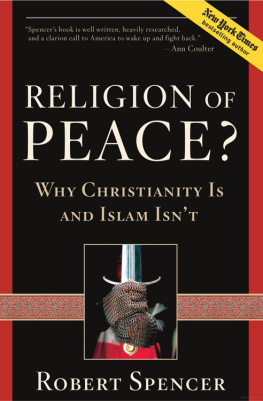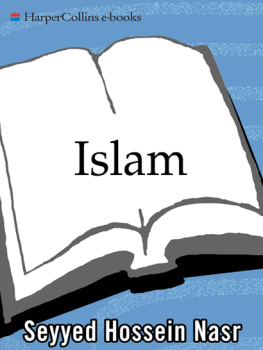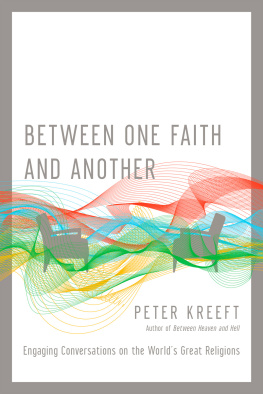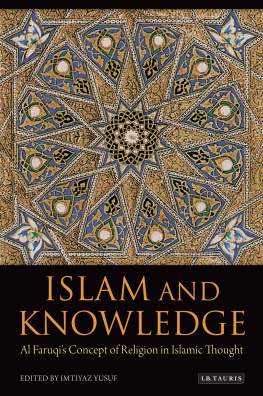Christianity, Islam, and the West
Robert A. Burns
University Press of America, Inc.
Lanham Boulder New York Toronto Plymouth, UK
Copyright 2011 by
University Press of America, Inc.
4501 Forbes Boulevard
Suite 200
Lanham, Maryland 20706
UPA Acquisitions Department (301) 459-3366
Estover Road
Plymouth PL6 7PY
United Kingdom
All rights reserved
Printed in the United States of America
British Library Cataloging in Publication Information Available
Library of Congress Control Number: 2011926390
ISBN: 978-0-7618-5559-0 (paperback : alk. paper)
eISBN: 978-0-7618-5560-6
 The paper used in this publication meets the minimum requirements of American National Standard for Information SciencesPermanence of Paper for Printed Library Materials, ANSI Z39.48-1992
The paper used in this publication meets the minimum requirements of American National Standard for Information SciencesPermanence of Paper for Printed Library Materials, ANSI Z39.48-1992
Preface
This book has its origin in a course I have taught at the University of Arizona for some thirty years. The course is entitled Comparative Religions and deals with the history and teachings of the Abrahamic religions: Judaism, Christianity, and Islam. Those who have enrolled in the class have come from diverse religious and cultural backgrounds. Whatever the mix, there has been a shared curiosity about all three religions, but since the attack of 9/11 on the World Trade Center, the students are especially interested in Islam. Like most Americans, they have little or no knowledge of the Islamic religion.
This book deals briefly with the origin and main teachings of the Islamic religion. It then discusses the kind of questions asked of me most frequently. Hopefully, this approach will be helpful not only when used in courses in comparative religions, but will be useful to study groups and to other interested individuals as well. The glossary of technical words and the selected bibliography (Further Reading) should also be an aid to the reader.
In putting together a book of this scope, acknowledgement of those whose work I have drawn from could be almost endless. Hopefully the textual references given throughout the book indicate sufficiently my debt to the scholars who have influenced my thinking.
Introduction
Relations between Christianity and the Islam have been mutually hostile for centuries. From the 7th through the 15th century there were Muslim invasions of The Holy Land, Central Europe, Italy, Spain, and North Africa. Christians reacted principally through the Crusades (1095-1291) which resulted in anti-Christian attitudes among Muslims. At the same time, Christian disdain toward Islam intensified. Throughout the following centuries, very few Christians have had an authentic knowledge of Islam and such has been true of Islam vis--vis Christianity.
The 19th century and the historical studies of Islam which it produced paved the way for a less polemical assessment of Islam on the part of Christian theology. Nevertheless, colonialism (the domination of much of the Islamic world by European powers from the 17th through the 20th century) and the military, economic, cultural, and religious expansion of the West during the past two centuries, has led to greater hostility on the part of the Islamic world. Mutual understanding and dialogue, for the most part, has come to a standstill.
Misinformation about Islam, and for that matter, sheer ignorance, is common today in the United States. The purpose of this book is to help alleviate this problem. Dialogue between the two religions, which hopefully will bring mutual understanding and respect, is a necessity if world peace is to be attained. Roman Catholicism at the Second Vatican Council (1962-1965) encouraged such dialogue in the Declaration on the Relationship of the Church to Non-Christian Religions by urging Catholics and Muslims to forget the past and to strive sincerely for mutual understanding, making common cause for safeguarding and fostering social justice, moral values, peace and freedom. Other Christian communities have stated similar ideas. As a result, a number of interfaith conferences have been held but unfortunately have reached very few adherents on either side.
On October 17th, 2007, a letter signed by 138 Muslim leaders was sent to Pope Benedict XVI and other Christian leaders throughout the world, calling for dialogue between the two religions for the sake of world peace. In addition to the Pope, who accepted the invitation, the letter is addressed to all of the Eastern Orthodox Church, the Calcedonian and pre-Calcedonian Churches, to many Protestant Churches, and to the World Council of Churches. Many accepted this invitation.
Common ground for this dialogue, which began in November 2008, is rooted in the twofold commandment to love God and ones neighbor. As the dialogue unfolds, it will be based on respect for every human person, an objective knowledge of one anothers religion without downplaying differences, and on a commitment to promote mutual respect for one another. When this occurs, Muslims and Christians can begin to work together to promote justice and peace throughout the world. The attack on the World Trade Center on September 11th, 2001, the war in Afghanistan, the situation in Iraq and elsewhere in the Middle East, confirm the urgent need for such dialogue. Since this book is intended primarily for a Christian readership, an introduction to Islam and its teachings will be presented. Included in this study will be an examination of commonalities and differences between the two religions and other factors which must be understood if a true dialogue is to occur. In regard to this, the results of the Gallup World Poll as found in Who Speaks For Islam? What a Billion Muslims Really Think by John L. Esposito and Salia Magahed, will be used as a vital source throughout this book once a brief introduction to Islam has been presented.
Notes
1. The Dogmatic Constitution on the Church, in Walter Abbot, ed., The Documents of Vatican II (New York: Herder, 1966).
2. John L. Esposito and Salia Magahed, Who Speaks for Islam? What a Billion Muslims Really Think (New York: Gallup Press, 2007).
Part I
THE ISLAMIC RELIGION
Chapter One
Muhammad and the Quran
Muhammad was born in 570 in the city of Mecca. He was a member of the powerful Quraysh tribe. His clan, the Hashim, was not prominent but it was well regarded. His father, Banu Hashim, died before he was born and his mother died when he was six, perhaps even earlier. He was raised by his grandfather, Abd al-Muttalib, who acted as his guardian, but died two years later. His uncle, Abu Talib, then became his guardian. In his youth, Muhammad was a shepherd but later worked in the caravan trade. In his twenties he worked for a wealthy woman, a widow named Khadijah, as a manager of her caravan. Muhammad and Khadijah married in 595. He was twenty-five and she is said to have been forty. However, it is possible she was somewhat younger since she and Muhammad had six children, four daughters and two sons. Neither of the sons survived childhood.
Muhammads call to be a prophet occurred in 610. This took place in a cave on Mt. Hira, near the city of Mecca. Muhammad had often gone there to pray and meditate. He was always a spiritual person. The angel Gabriel appeared to him and told him he was to be the messenger of God. He was told to recite the revelation he received. Quran means recitation in Arabic. Muhammad, who was illiterate, served as Gods intermediary. Muslims believe that the Quran is the literal word of God. From 610 until his death in 632, a period of twenty-three years, Muhammad continued to receive revelations. During this time, the Qurans 114 chapters (called suras) were revealed to him. Muslims believe the Quran was preserved in oral and written form during the lifetime of Muhammad. The entire text was collected into an official standardized text during the reign of the caliph Uthman (644-656). In length, the Quran is approximately four-fifths the size of the New Testament. For Muslims, the Quran is entirely Gods word except for its arrangement, verse numbering, and the names of the surahs (chapters) which were produced after Muhammads death.











 The paper used in this publication meets the minimum requirements of American National Standard for Information SciencesPermanence of Paper for Printed Library Materials, ANSI Z39.48-1992
The paper used in this publication meets the minimum requirements of American National Standard for Information SciencesPermanence of Paper for Printed Library Materials, ANSI Z39.48-1992